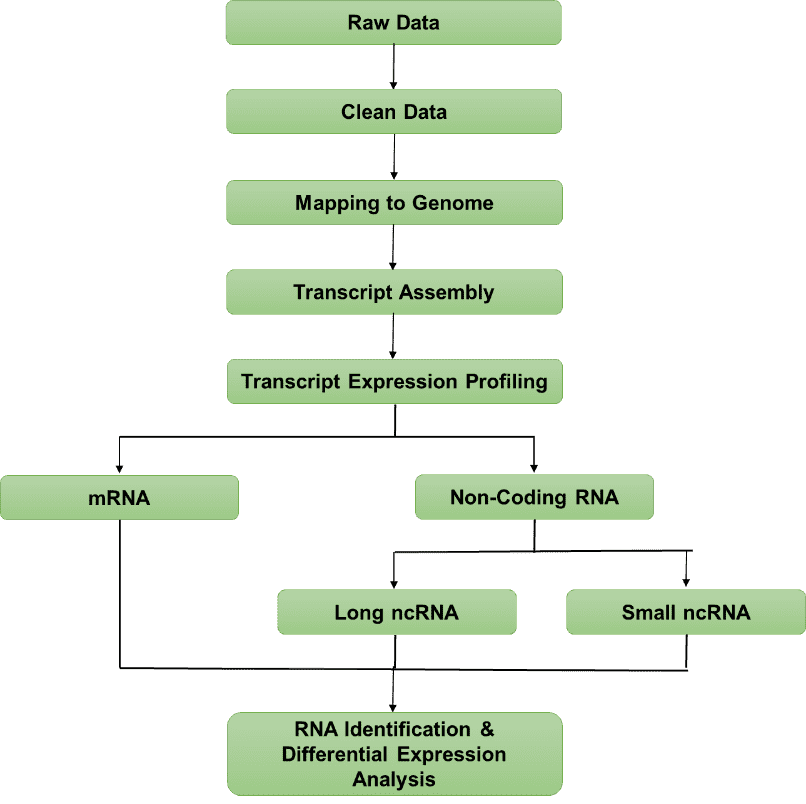Transient Transcriptome Sequencing
Transient transcriptome sequencing (TT-Seq) is an RNA-Seq method that collects and sequences all RNA segments synthesized over 5 minutes. This scheme uniformly maps the complete run of RNA-producing units and gauges rates of RNA synthesis and degradation. Since 5 minutes is not long enough to completely degrade even the most transient RNA, this strategy can identify the synthesis of most RNA without bias.
Overview
When cells perform various life functions, the corresponding gene activity must be strictly controlled. This tightly controlled function is performed by regulatory DNA messaging between genes. When regions of regulatory DNA are activated, they are transcribed into RNA. But the transcribed RNA molecules are quickly degraded by cells, making them difficult to detect. But it's these short-lived RNA molecules that often act as crucial molecular switches, specifically activating a gene that's needed in the body. Transient Transcriptome Sequencing (TT-seq) uses a highly sensitive method to capture and characterize every short-lived RNA molecule.
Transient transcriptome sequencing (TT-seq) is a variation of 4-thiouridine (4sU) sequencing, which labels newly synthesized RNA by metabolic incorporation of 4sU in live cells. Examination of this RNA can give data on RNA synthesis, co-transcriptional processing, and degradation. TT-seq overcomes this limitation by combining a short 4sU labeling pulse to the newly synthesized RNA fragments with an RNA fragmentation step. The labeled RNA fragments are purified and sequenced, resulting in a low fraction of contaminating non-labeled RNA. This technology is simple to utilize and incorporates RNA spike-in controls for global normalization between datasets from distinctive samples. TT-seq empowers studies of the kinetics of RNA metabolism, and mechanistic studies of transcription regulation. TT-seq is as well ideally suited to screen rapid changes in gene activity and the dynamics of enhancers during transcription reactions.
Features
| Competent in Profiling Short-Lived RNA |
Simple and Efficient |
Comprehensive Analysis |
Multiple Applications |
| A low fraction of contaminating non-labeled RNA guarantees the identification of most RNA synthesis. |
Simple to utilize and efficient profiling of RNA metabolic kinetics. |
Profiling mRNAs, long intergenic non-coding RNAs (lincRNAs), enhancers, antisense RNAs, promoter associated RNAs, etc. |
Detect rapid changes in gene activity and the dynamics of enhancers during transcription reactions to meet research needs. |
Project Workflow

1. Sample Preparation
RNA spike-in pool and 4sU labeling; RNA extraction

2. Library Preparation
RNA Fragmentation; Biotinylation; Labeled RNA Pull-down; Clean-up and DNase I Digestion

3. Sequencing Platform
Illumina HiSeq; PE50/75/100/150; >10G clean data

4. Data Analysis
Perform custom bioinformatics transient transcriptome analysis.
Bioinformatics Analysis Pipeline
In-depth data analysis:
- Gene fusion detection
- Differential expression analysis
- Pathway analysis
- SNV & InDel detection
- Splicing analysis
- Prediction of novel mRNA, lncRNAs (e.g., lincRNAs, enhancer RNAs, antisense RNAs) and snRNAs (e.g., promoter associated short RNAs)
- Discovery of novel transcripts and mutations, even in FFPE tissue
Sample Requirements
RNA amount: Total RNA ≥ 5 ug (without degradation or DNA contamination); RNA purity: OD260/280 = 1.8~2.2; OD260/230 ≥ 1.5; RNA quality: 28S:18S ≥ 1.5,RIN ≥ 7
Please make sure that the RNA is not significantly degraded.
Sample storage: RNA can be dissolved in ethanol or RNA-free ultra-pure water and stored at -80°C. RNA should avoid repeated freezing and thawing.
Shipping Method: When shipping RNA samples, the RNA sample is stored in a 1.5 mL Eppendorf tube, sealed with sealing film. Shipments are generally recommended to contain 5-10 pounds of dry ice per 24 hours.
Deliverable: FastQ, BAM, coverage summary, QC report, custom bioinformatics analysis.
References:
- Villamil G, Wachutka L, Cramer P, et al. Transient transcriptome sequencing: computational pipeline to quantify genome-wide RNA kinetic parameters and transcriptional enhancer activity. bioRxiv. 2019 Jan 1.
- Schwalb B, Michel M, Zacher B, et al. TT-seq maps the human transient transcriptome. Science. 2016 Jun 3;352(6290).
* For Research Use Only. Not for use in diagnostic procedures.




